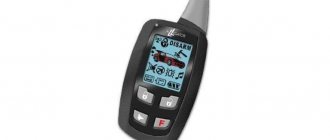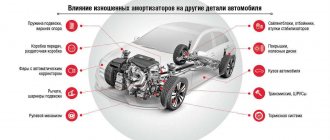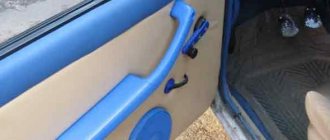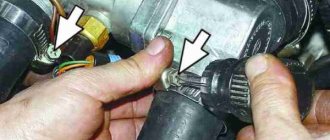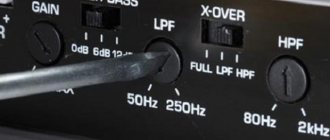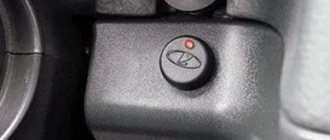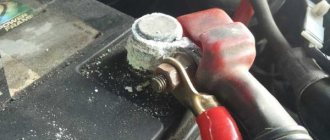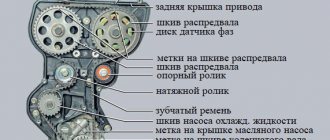- home
- Useful
- …
Question from a reader:
“Good day to you and your site. I have a question related to the automatic transmission and the variator, or rather the lever! I have a Nissan car, and on my automatic transmission, or rather on the variator, there are two buttons on the lever! Why are they even needed and what is regulated by them? Thanks for the answer! Marat."
Your question is clear, read the answer below……..
Indeed, almost all automatic transmissions have gear levers (selectors) with buttons. Some have more of them, some have less, but in any case, there are no such automatic transmissions on the levers that have no buttons at all, at least I haven’t seen one (there will definitely be one). Today I will talk about their purpose, using my Chevrolet Aveo as an example.
What does the PWR button on a car mean?
PWR - The program is configured to maximize the use of engine power, so upshifts occur in the area of maximum engine speed, at which the engine develops maximum power. In this case, the car accelerates with significantly greater acceleration.
Interesting materials:
How to understand 1 2 soda? How to understand 4-dimensional space? How to understand the actual residential address? How to understand Budget Accounting? How to understand that the battery is faulty? How to understand that the watch has become magnetized? How do you know if this is an artistic style? How do you understand that this is a story? How do you know if microsporia is going away? How can you tell if a newborn is cold or hot?
How to use "Shift lock"
In order for the button to have the desired effect, you must take the following steps:
- Click on it.
- Do not release until you have moved the shift lever to the “N” position if you need to tow the vehicle with another vehicle.
- Release the button on the machine.
- Then you can push the car or transport it on a trailer.
Read
Which automatic transmission is the most reliable and best, rating of automatic transmissions
Now you know how and where to use this key. It may look different on different brands of vehicles.
For example:
- on Toyota cars you will find it slightly recessed into the selector. And it will be called not just Shift Lock, but “Shift Lock Release”;
- on Kia the switch will be hidden under a special panel. The lid must be opened to use the “Shift lock”;
- There are no identification marks on the Ford Focus and other modifications of vehicles that came off the assembly line of a well-known plant. On the automatic transmission selector of these cars you will find just a button without a name;
- on Nissan Shift Lock looks exactly the same as on Toyota.
Read
Parking with an automatic transmission: parking modes and proper parking with an automatic transmission for beginners
If you need to replace the button, you can contact any auto store. The cost of a key starts from 130 rubles. For Toyota Camry ShiftLock is sold under catalog number 3356333230.
What to do if there is an RCD in the panel
The poor condition of electrical panels in old houses requires reinsurance to avoid fires and casualties. Therefore, in many cases, protection devices (RCDs) are installed to ensure stability in the power supply circuit.
RCD - residual current device
They are designed to automatically turn off power in the event of a sudden electrical leak and do this in milliseconds. If this protective device (RCD) is installed in the panel, then in order to turn off the electricity in the apartment, you can limit yourself to simply turning off the RCD. It’s better to turn off both it and the machine.
List of situational moments that require turning on the button
However, if the automatic transmission has gone into emergency mode or the engine has stalled in the middle of a busy highway, you can safely use Shift Lock to, for example, set the rocker to the neutral position. It will be easier for another car to tow your box without harm if there is no tow truck nearby.
Read
Typical problems and repairs of automatic transmission f4a42
Now I will describe situations in which the use of “Shift Lock” on an automatic transmission will be useful to you:
- stopping at a gas station;
- car breakdown requiring towing, as I wrote above;
- stopping in front of the turnstile to deposit money.
Thanks to this key, you can always unlock the automatic transmission and put the rocker in the desired position. By the way, on old boxes, instead of a key, the driver found a hole for the key. The key acted as a “Shift Lock” unlocker, by inserting which it was also possible to change the position of the selector lever on a locked automatic transmission.
Manu
Alternative names: Hold, ETC Snow, Snow, current gear lock switch. When pressed, the currently selected gear is blocked from downshifting or upshifting, and a warning lamp in the instrument cluster lights up.
The button can be used in conjunction with the “D” mode and a manually selected gear – values 1, 2, 3, L on the mode scale.
In the first case, the car will start from 2nd gear. This will avoid slipping on ice and snow. In the second case, it makes it easier to climb/overtake and allows you to effectively use engine braking on steep descents, preventing overheating of the brake system elements and saving their life.
Varieties by poles
Automatic machines can have from 1 to 4 poles, which is determined by the power of the connected electrical equipment and the number of network phases.
Classification according to the number of poles of circuit breakers:
- A single-pole circuit breaker is capable of protecting the network to which low-power devices are connected. Installation is carried out on the phase wire, the neutral wire is excluded.
- A two-pole device is relevant for a line to which fairly powerful household appliances are connected (washing machine, electric stove, boiler).
- Three-pole model. Intended for semi-industrial scale with connection of installations: pumps, devices for auto repair shops or construction work.
- The four-pole circuit breaker protects against short circuits and overloads of four-wire networks.
For a four-core cable, only three- and four-pole circuit breakers are installed.
Overdrive
The automotive industry produces several types of automatic transmissions. These are robotic gearboxes, CVTs, preselective robots with two clutches, as well as hydromechanical automatic transmissions, which are the most common. They have 4 or 6 steps.
Such boxes usually have several selector positions, namely D, R, N and P. The first is “Drive”, which is used while driving, the others are “Reverse”, “Neutral” and “Parking”, which is activated when the car is parked . If you study the console in more detail, you will notice slots for manual mode with “-” and “+” signs, where you can forcefully change gears. However, on old boxes there is another button that is not very noticeable and is sometimes hardly used by the owners. This is an OD (Overdrive) function.
The OD button is usually located outside the selector and placed on the central tunnel, so it is little associated with the operation of an automatic transmission. It is small in size and sometimes marked with a snowflake, hinting that it is recommended to use the OD mode in winter, when the roads are covered with snow. This function allows the box not to go to the highest level and always operate at engine speeds in the range of 2-4 thousand, which makes it possible to always keep the engine at maximum torque. When OD mode is engaged, the 4-speed automatic transmission simply will not shift above 3rd gear. In slushy snow, extra Newton meters won't hurt. High revs also help to effectively brake the engine when releasing the gas.
Question answer
How to slip correctly on an automatic transmission?
The OD button is not always placed directly on the tunnel. Often it is placed on the gearbox lever in some inconspicuous place on the side or bottom of the selector. It is also possible that the automatic transmission does not have an overdrive program at all. On many modern cars it is replaced by a sport mode, which also maintains lower transmission levels for a long time.
Connection diagram without grounding
Regardless of the type of network, when connecting difavtomats, you should always follow the following rules:
- Power wires should always be connected to the device from above, and output wires (to the load) - from below. Most difavtomats have a corresponding designation for these connectors and a circuit diagram. Accidentally connecting in reverse order can cost a pretty penny if it leads to the machine burning out. If the available length of wires is not enough, it is best to replace them. As a last resort, extend or turn over the difavtomat on the DIN rail (the main thing is not to get confused during further installation).
- The polarity of the contacts must always be observed. According to the international standard, on all devices, the connectors for connecting the neutral wire are designated N, and the phase ones are designated L. The order of current flow is indicated by numbers: 1 - incoming wire, 2 - outgoing. Please note that the device may even work if connected incorrectly, but incorrect polarity will result in it not responding to overloads and short circuits.
- Some electricians, out of habit, can connect all zeros to one jumper, since this is required by the connection diagrams of many devices. However, in a difavtomat such a connection will always cause a conflict and turn off the power. For normal operation, the zero of each RCBO can only be connected to its own circuit.
O/D Off
The second name is Overdrive mode. By default it is disabled and blocks the use of higher gears. The mode status is displayed by a lamp on the instrument cluster or by the backlight of the button: on - off, off - on.
It is recommended to turn on the “Overdrive” mode when driving on the highway at speeds above 80 km/h. This will reduce fuel consumption by reducing the gear ratio between the primary and secondary gears, the engine speed required to maintain speed, and the consistency of the latter.
In the city, it is better not to turn on the mode, since the automatic transmission will often switch between direct and overdrive gears, reducing the life of moving parts.
Connection diagrams
The wiring diagram for the difavtomat is easy to read even for an inexperienced electrical engineer. In principle, it is not much different from the connection diagrams for other devices installed in the switchboard. Therefore, the main rule for them is exactly the same: a differential circuit breaker can be connected to the phase wires and neutral only of the line (branch) that it protects.
Introductory machine
Let's consider two main circuits for connecting differential automatic machines. The first of them is sometimes called the “input circuit breaker”, since in this case the device is placed in the switchboard on the input cable and simultaneous protection of all electrical circuits and groups in a given network is provided.
The residual current circuit breaker for such a circuit must be selected individually, taking into account the power consumption and other operating parameters of the network. Among the advantages of this method of organizing protection are:
- when reacting to a malfunction, the power supply to the entire apartment is turned off;
- repairs will take longer, since it is not known exactly which circuit the breakdown occurred on; even the reason for the shutdown is unknown (short circuit, current leakage).
Separate machine
A lightweight version of the previous scheme is also known, in which, for the sake of economy, a common differential switch is not installed. In terms of functionality, this method is practically no different from the previous one.
In all the above diagrams, the cables are designated according to the following principle: blue lines are neutral wires, red lines are phases, and yellow dotted lines are grounding.
What kind of lighting do you prefer?
Built-in Chandelier
Expert opinion
Viktor Pavlovich Strebizh, lighting and electrical expert
Any questions ask me, I will help!
Their installation usually requires more space on the DIN rail than for 4 modules, since space is required to accommodate the differential protection unit. If there is something you don’t understand, write to me!
Starting and stopping with automatic transmission
Most drivers who switch from a manual to an automatic transmission initially automatically perform actions that they are accustomed to performing repeatedly when driving a car with a manual transmission. Therefore, before starting to drive with an automatic transmission on the road in general traffic, such drivers are advised to first practice alone.
So, the standard procedure for starting a car with an automatic transmission is as follows:
- Insert the key into the ignition.
- Depress the brake pedal with your right foot (the left foot is not used when driving with an automatic transmission).
- Check the position of the gear shift lever - it should be in the “P” - “parking” position.
- Start the engine (with the brake pedal pressed).
- Also, with the brake pedal pressed, switch the PP lever to position “D” - “drive” (moving forward).
- Fully release the brake pedal, after which the car will move off and begin to move forward at a low speed - about 5 km/h.
- To increase the speed, you need to press the gas pedal. The harder you press the gas pedal, the higher the gears and speed will be.
- To stop the car, you need to remove your right foot from the gas pedal and press the brake pedal. The car will stop.
- If you plan to leave the car after stopping, then with the brake pedal pressed, move the gear lever to the “P” - “parking” mode. If you need to stop in a traffic jam, at a traffic light or a pedestrian crossing, then, naturally, there is no need to switch the PP lever to “parking”. Once you decide to continue driving again, release the brake pedal and press the gas pedal to increase speed.
Many modern automatic transmissions have an imitation of the mechanical gear shift mode “M” (as on a manual transmission) for up/down gears using the “+” and “–” buttons on the gearshift lever. That is, the driver is given the opportunity to manually increase or decrease gears, taking away this function from the “automatic”. In this case, the transition to a mechanical gear shift mode can be made while driving, when the car is already driving in “D” mode.
To prevent engine damage when switching to manual mode “M” while driving, all automatic transmissions have special protection. Switching to manual control “M” is relevant in the following situations:
- When driving off-road, use a lower gear to avoid slipping.
- When coasting down a hill, with engine braking. It is not recommended to use the neutral “N” mode for coasting, as it is harmful to the automatic transmission. And coasting in “D” mode is not entirely convenient, since there is a gradual decrease in speed.
- For comfortable cornering and other maneuvers, including sharp acceleration when overtaking.
Starting the engine with automatic transmission
Starting an engine with an automatic transmission has the following features:
- In a car with automatic transmission there are only two pedals: brake and gas.
. Therefore, the driver's left leg is practically not used. When starting the engine, the gas pedal is not pressed, but in some brands of cars the brake pedal must be pressed, otherwise the engine will not start (read the operating manual).However, driving instructors advise making it a rule to always press the brake pedal before starting the engine with an automatic transmission. This will prevent the car from spontaneously moving in neutral mode “N”, and will also allow you to quickly switch to driving modes “D” or “R”. (It will not be possible to switch to the indicated modes and move away without pressing the brake pedal).
- In cars with automatic transmission, protection is provided - automatic engine start blocking if the gear shift lever is in the wrong position
. This means that an engine with an automatic transmission can only be started if the gear shift lever is in one of two positions: either “P” (park) or “N” (neutral). If the PP lever is in any other position intended for movement, the locking protection against incorrect starting will be activated.This protective function is very useful, especially for beginners, and especially in cities with high “car density”, where cars are parked closely together in parking lots and in traffic. After all, even experienced drivers sometimes forget to “decelerate the car” before starting the engine, as a result of which, when starting, the car immediately starts moving and crashes into the nearest car or obstacle.
You can start the engine with an automatic transmission in both “P” (parking) and “N” (neutral) modes, but manufacturers recommend using only “P” mode. Therefore, it is better to set one more rule for yourself - park and start the engine only in “parking” mode.
- After turning the key in the ignition before starting the starter, it is recommended to wait a few seconds
to give the fuel pump time to turn on and pump up the compression.
It should be remembered that on some brands of cars with automatic transmission, gear shifting is impossible without inserting and turning the key in the ignition (unlocking the gearbox). Also, on some brands it is impossible to remove the key from the ignition switch if the PP lever is in the “D” position. (Read the instruction manual).
Power
Alternative names – Sport, ETC PWR. When turned on, the gear buttons shift at high engine speeds, and the corresponding indicator turns on on the instrument cluster.
This mode is recommended for use on slopes on the highway, at speeds above 90 km/h. When pressed, the gear will decrease and the car will accelerate.
Factory gearbox markings
Each automatic transmission belongs to a specific model range of the manufacturer. Knowing the model number, you can choose the right spare parts for repair or a replacement contract box.
There are many models, and each has its own designation. You can find it out either from the car documentation or on the Internet, knowing the car brand, gearbox type (see above), country and year of production.
Each automaker uses its own digital and alphabetic numbering system. For example, consider the Hyundai-Mitsubishi F4A41 hydromechanical gearbox:
- F – code designation indicating the type of drive of the car, in this case it is F – Full, that is, the gearbox is intended for all-wheel drive cars;
- 4 – number of gears in the box;
- A – a sign that the transmission is automatic (Automatic);
- 41 – sub modification number, indicating the amount of torque transmitted by the gearbox and some other details.
There may also be an additional alphanumeric indicator that helps determine the engine for which the automatic transmission is suitable and the car model. For example, for the same Mitsubishi boxes, the designation 2J1Z indicates a model of the concern under the Diamant brand with a 2.5-liter engine, and so on.
The specific marking and its meaning in each case should be clarified with the manufacturer.
Classification by time-current indicator
The number of false alarms of automatic circuit breakers under uneven load on the network is optimized due to different speeds of response to exceeding the rated current. The dependence of the network shutdown time on the strength of the flowing current determines the following types of circuit breakers:
- A. Available from European manufacturers. The most sensitive model. It responds instantly to deviations from the norm. Typically used to protect lines with connected high-precision equipment. (Current rating 2-3). Rarely installed.
- B. Designed for rooms equipped with old aluminum wiring. Suitable for long lines, lighting lines or circuits without possible sudden voltage changes. It turns off with a slight delay of 5-20 seconds at a current rating of 3-5.
- C. More often found in modern apartments to protect outlet lines into which a sufficient amount of electrical equipment is connected (washing machines, dishwashers, freezers, heaters, microwave ovens, LCD TVs). Shutdown occurs in 1-10 seconds at a current multiple of 5-10. This principle is needed to stabilize operation with a slight difference.
- D. Protection is optimal for lines with transformers or high inrush currents. Circuit breakers of this class cannot be connected to consumers oriented to work with protection classes C and B. At 10-20 rated current it turns off in 1-10 seconds. Lowest sensitivity to increased current. Sometimes it is customary to install it on the building itself in order to secure apartment automatic machines. If they suddenly do not work, the entire building will be disconnected from the network.
These are the most common types. The range of production models has been supplemented by three more groups: L, K and Z.
Automatic gearbox, meaning of letters, photo
Here, for example, are ordinary photos of some types of automatic transmissions in automobile gearboxes. For many mechanical enthusiasts, these symbols do not mean anything, but only confuse them more and distance them from the automatic transmission.
Therefore, let's try to dispel the fog of doubt and ignorance by explaining the meaning of each symbol on the automatic transmission:
- R – translated in English as Parking, parking or parking. The car is switched to this mode only after a complete stop. If you are standing on a hill, it is recommended to first put the car on the handbrake and only then move the lever to the Parking position, after which you can leave the car and go about your business
- R - literally Reverse, back, back - that is, normal reverse gear, engage it when there is a need to drive in reverse
- N - translated as Neutral, that is, neutral, neutral speed, it is mainly used for towing a car, usually when standing in a traffic jam, it is recommended to hold the brake pedal without moving the car to the neutral position - since this is not a manual transmission, but nevertheless, many automatic transmission owners when parking, especially in traffic jams, move the lever to position N, because you must admit that keeping your foot on the pedal for 20-30 minutes is not at all comfortable
- D or A - you can find both of these designations Drive or Automate, which is essentially the same thing, that is, you switch to this position when you need to drive, squeeze the brake, put the speed lever in position D or A and simply press the gas pedal, smoothly releasing the pedal brakes and all movement has begun, now there is no need to switch the handle, just regulate the speed of your movement by pressing the gas pedal in your car with your foot
- L or B (l, 1, 1L) - some types of automatic transmissions are equipped with additional functions (Low or Bottom) which can literally be translated as slow or first gear. Typically used on ice, very steep descents or uphills, or for engine braking.
- B or simply Block often means differential locking, usually on jeeps or all-wheel drive cars, in which cases it is better to read the manual for your car model
- 2 or 2L, 3 or D3, 4 or D4 - means limiting the speed switching by the gearbox, that is, set it to 2 - it means the gearbox will not shift above second gear no matter how hard you press on the gas, set it to mode 3 - the box will not shift above third gear will switch no matter what you do with the accelerator pedal, the same will happen in 4 - the shift will not occur above the fourth speed, for example, you have 6 steps in the box, you set it to mode 4 - this means the car itself will shift from 1st to 4th gear, auto to 5th -and 6 will no longer switch
